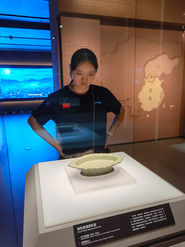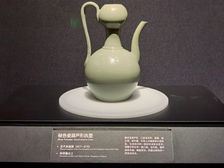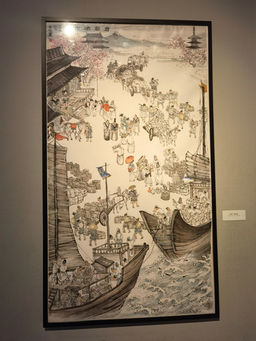top of page
Mi-se (secret color) porcelain
Mi-se porcelain, or called Secret color porcelain, is internationally known as the most "mysterious" Chinese porcelain, which was originally only enjoyed by members of the royal family.
Mi-se porcelain represented the highest level of ceramic craftsmanship at that time and became an important object of export trade in the late Tang Dynasty. It was an important carrier of economic and cultural exchanges between ancient China and foreign countries, and as one of the representatives of Chinese culture, it spread in Asia, Europe, and Africa.


Bowl with dragons amid waves
This Mi-se large bowl with three dragon frolicking in waves comes from the Yue Kilns, which began making celadons as early as the second century BCE. This Bowl is from the Five Dynasties (907-60), from the Rogers Fund, 1918, collected in the Metropolitan Museum of Art, New York.
Eight-sided bottle
The Mi-se octagonal "clean water porcelain bottle” is a late Tang Yue kiln secret color porcelain unearthed in 1987 from the underground palace of the Pagoda of Famen Temple in Fufeng, Shaanxi. It is now housed in the Shaanxi History Museum. This typical porcelain is a water storage device carried by Buddhist monks and is mainly used for hand purification, drinking, and religious ceremonies.


Mi-se porcelain censer with brown-glazed cloud pattern
The multi-layered structure (body, hollowed-out cover, and top decoration) combines practicality (incense burning) with decorativeness. The elements, such as the tiger-shaped feet and cloud patterns at the bottom, reflect the cultural preference of the Tang Dynasty for "auspicious beasts" and "auspicious clouds" in craftsmanship.

The celadon trade has also reached Southeast Asia, including Indonesia. The sunken Jingliwen ship was discovered on the north coast of Indonesia. It was an early maritime trade ship of the Northern Song Dynasty, and among the more than 300,000 pieces of porcelain salvaged from the ship, most of them were Yue kiln celadon. This is the largest discovery of Yue kiln celadon overseas.

Shanglinhu Yue Kiln was the central firing area for Tang Song Yue kiln celadon, with a historical usage period from the 2nd to the 12th century (Eastern Han to Song). Its products represented the highest level of celadon manufacturing in China, demonstrating an important stage of development in ancient Chinese celadon manufacturing. As a representative of the peak period of celadon in southern China, it had a significant impact on ceramic production in Egypt, Persia, the Korean Peninsula, and the Japanese archipelago from the 9th to the 11th century. The Shanglinhu Yue Kiln Site is a group of celadon kiln sites that have been discovered for a long time, with the largest scale and the most concentrated distribution of kiln sites. It is one of the most important sites in the ancient Chinese porcelain industry, showcasing the entire historical trajectory of the Yue kiln from its creation, development, prosperity, to decline, and is known as the "Outdoor Celadon Museum".
bottom of page

















